Trinidad is one of the most visited destinations in Cuba and we arrived with some trepidation about how much of a tourist trap it would be, but the pretty little colonial city soon charmed us as much as everyone else who goes there. Yes the historical centre bustles with tour groups during the day and there are dozens of overpriced bars and restaurants but you don’t need to venture too far down the cobbled streets to find normal life.
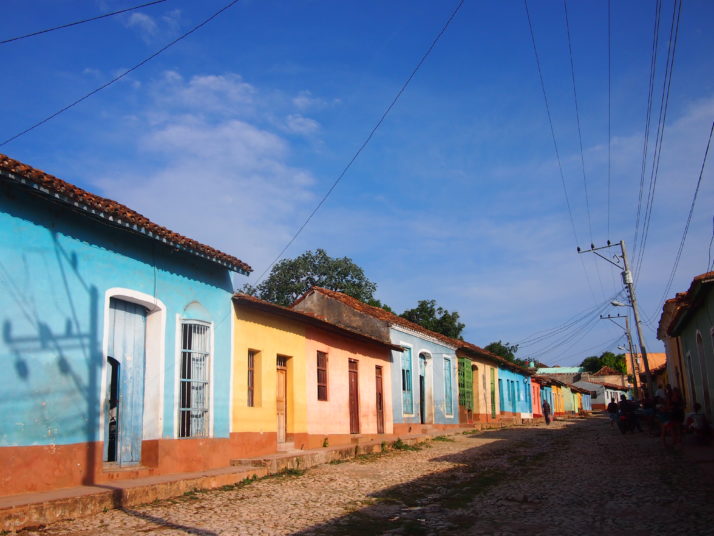 Pastel coloured houses line the cobbled streets in Trinidad’s historic centre
Pastel coloured houses line the cobbled streets in Trinidad’s historic centre
As well as wandering the streets and taking lots of photos there are a few small museums to seek out. Plaza Mayor is the centre of town and most of the attractions are within one block of it. It’s ringed with museums but, apart from poking our noses into the cathedral, we just visited the Art Gallery on its western edge which was almost more interesting for the 19th century frescoes preserved on its walls than the art on display!
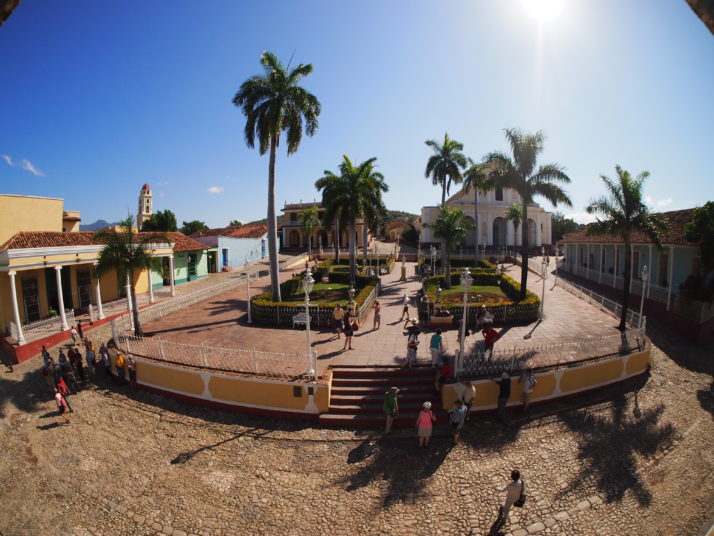 Plaza Mayor from the balcony of the art museum. The cathedral is in the top right of the square in the photo
Plaza Mayor from the balcony of the art museum. The cathedral is in the top right of the square in the photo
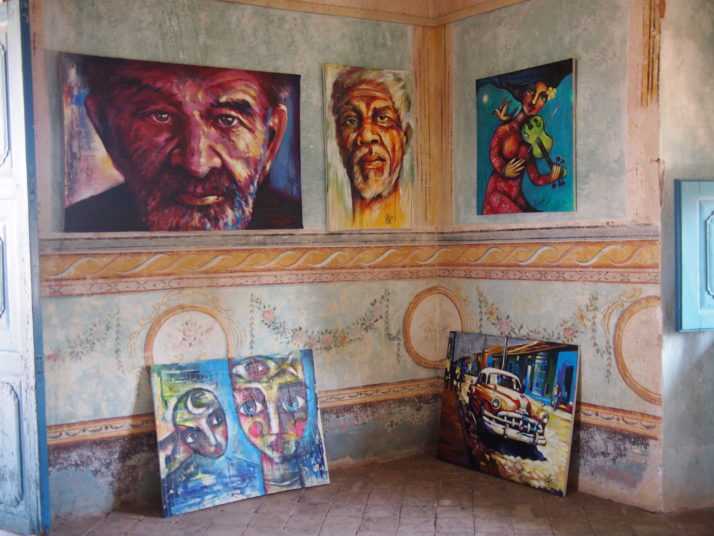 We liked the wall frescoes better than most of the art in the Art Gallery
We liked the wall frescoes better than most of the art in the Art Gallery
Trinidad is a well preserved example of a Spanish colonial city, and was built with the money generated in the sugar plantations in the nearby Valley de los Ingenios. Together the city and the former plantations have been declared a UNESCO World Heritage Site. The Municipal Museum is set in the one-time home of a sugar plantation owner and shows the opulent wealth that he and his family lived in. Rather bizarrely it’s weekly closing day is on a Friday which hadn’t occured to us as a possible reason for not being able to go in when we first visited.
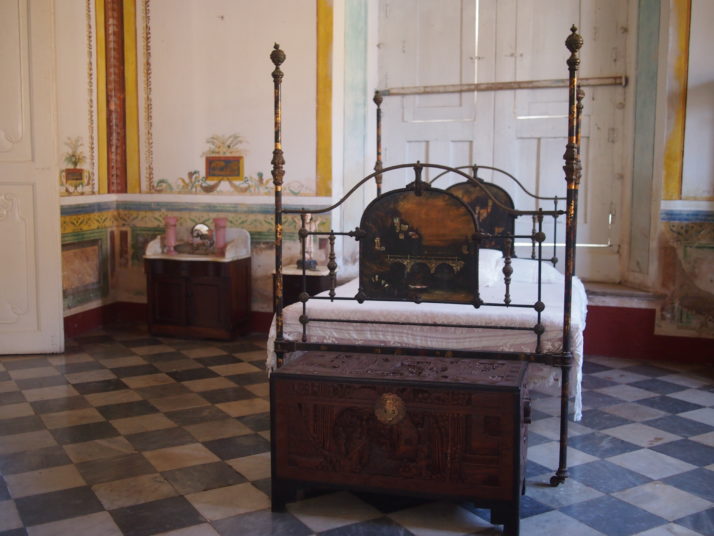 A sumptuous mother-of-pearl inlaid bedstead in the Municipal Museum
A sumptuous mother-of-pearl inlaid bedstead in the Municipal Museum
The yellow bell tower visible from much of the centre (see top left in the photo of Plaza Mayor) and the subject of many a postcard of the city belongs to the former convent of San Francisco de Asís. The building now displays a variety of exhibits about the fight against the counter-revolutionaries who based themselves in the nearby Sierra Escambray in the early 1960s and, according to the museum at least, were backed by the CIA.
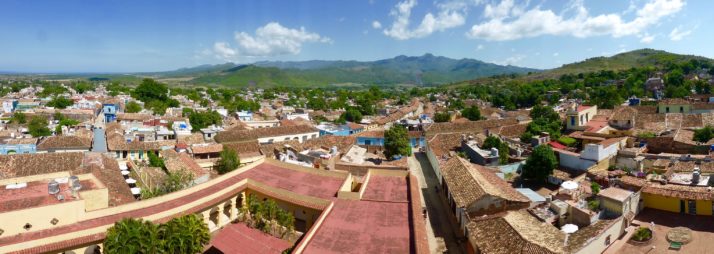 Entry to the museum also entitles you to climb the bell tower for panoramic views over the city and to the surrounding mountains
Entry to the museum also entitles you to climb the bell tower for panoramic views over the city and to the surrounding mountains
A little way outside the city to the north-east is a TV and radio antenna perched on a hill called Cerro de la Vigía. It’s a steep 30 minute climb up a rough road but from the top there are stunning views down Valley de los Ingenios and out to the sea. We did it in the late afternoon and I’d definitely recommend hiking in the cooler part of the day, though I think sunrise would be better than sunset if you can rouse yourself as the viewpoint faces towards the west.
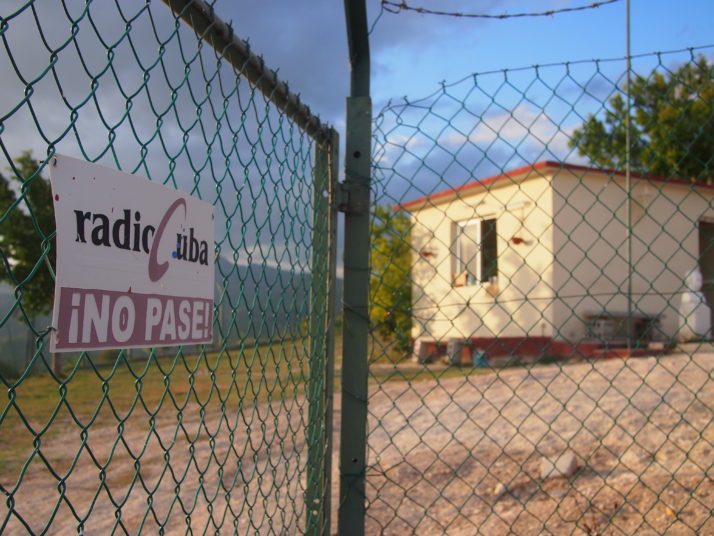 The enterprising security guard might even take you out back to stand on the roof of the shed containing the back-up generator (past the no entry sign) before selling you a cold can of beer!
The enterprising security guard might even take you out back to stand on the roof of the shed containing the back-up generator (past the no entry sign) before selling you a cold can of beer!
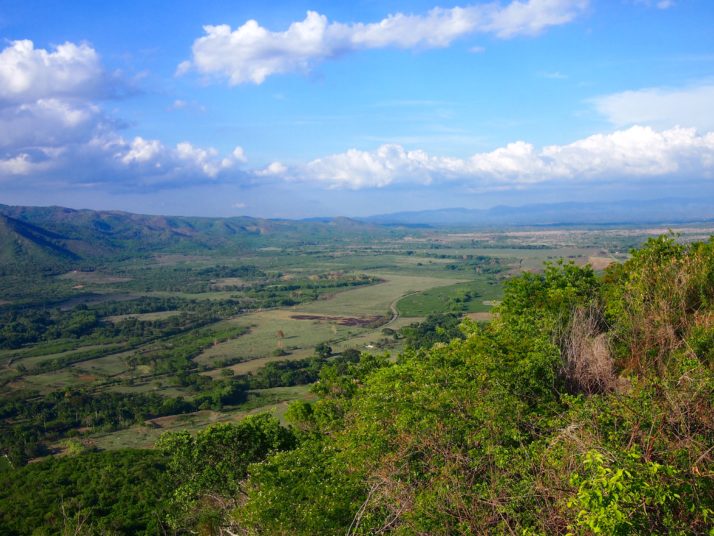 View down to Valley de los Ingenios (from the top of the generator shed!)
View down to Valley de los Ingenios (from the top of the generator shed!)
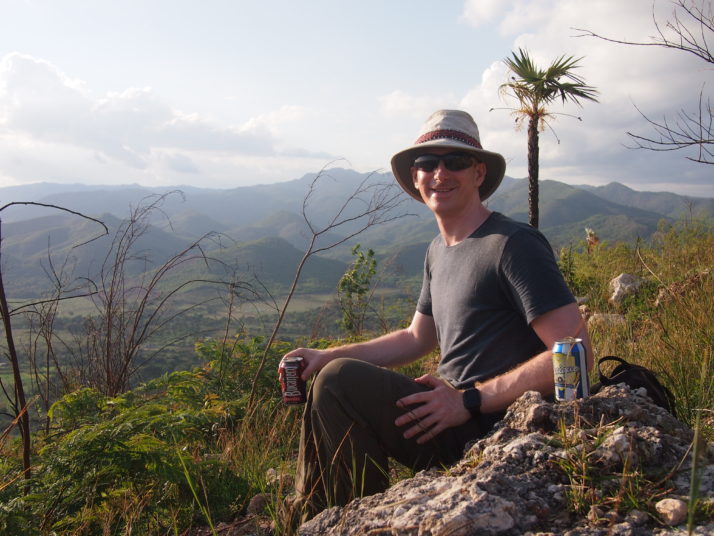 Admiring the sunset view with a cold beer
Admiring the sunset view with a cold beer
We hired a taxi to take us around a few of the sights in the Valley de los Ingenios. First up was a viewpoint restaurant which was fine, but for us the view from Cerro de la Vigía was better. Next up was San Isidro de los Destiladeros, the ruins of which are slowly being excavated and restored but are currently in an interesting intermediate state set in lush forest (complete with hordes of mosquitos).
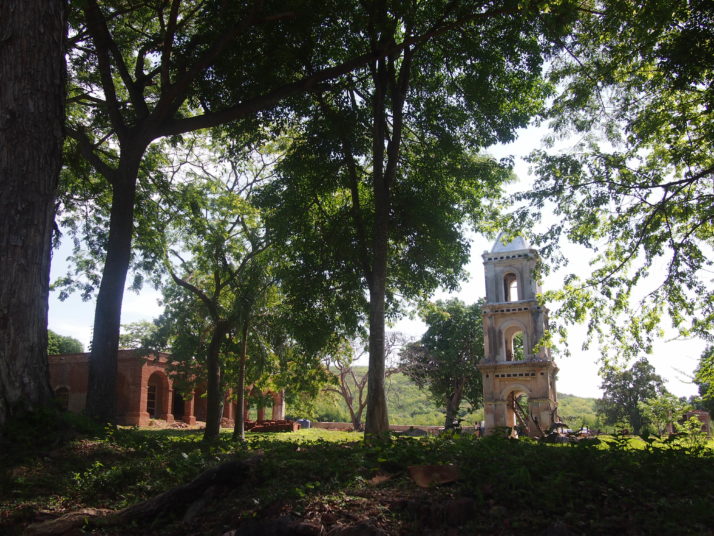 The owner’s house and bell tower at San Isidro de los Destiladeros are undergoing restoration works
The owner’s house and bell tower at San Isidro de los Destiladeros are undergoing restoration works
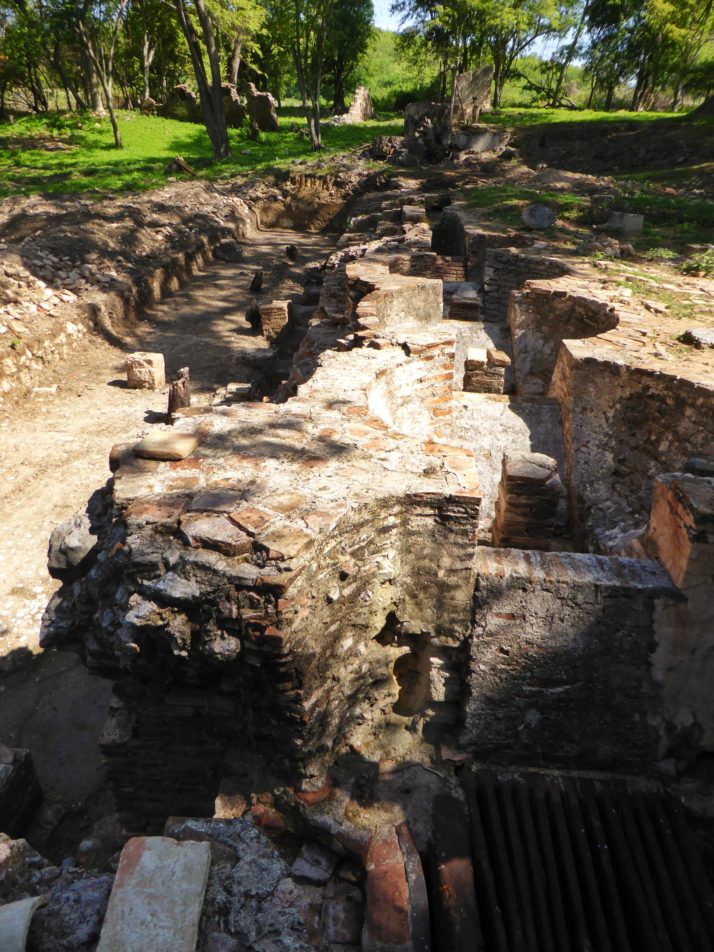 In the ruins of the sugar factory we could see how the system of boiling pans would be set over the furnaces to turn the sugar cane juice into molasses
In the ruins of the sugar factory we could see how the system of boiling pans would be set over the furnaces to turn the sugar cane juice into molasses
From San Isidro we moved on to Manaca Iznaga, the most touristed of all the sites we visited in the valley. Here the colonial mansion has been turned into a restaurant and the 44m tower which was used to keep an eye on the slaves who did the plantation work is open to tourists with good views from the top. Behind the restaurant is an old sugar press which would have been turned by animals or slaves to extract the juice from the sugar cane.
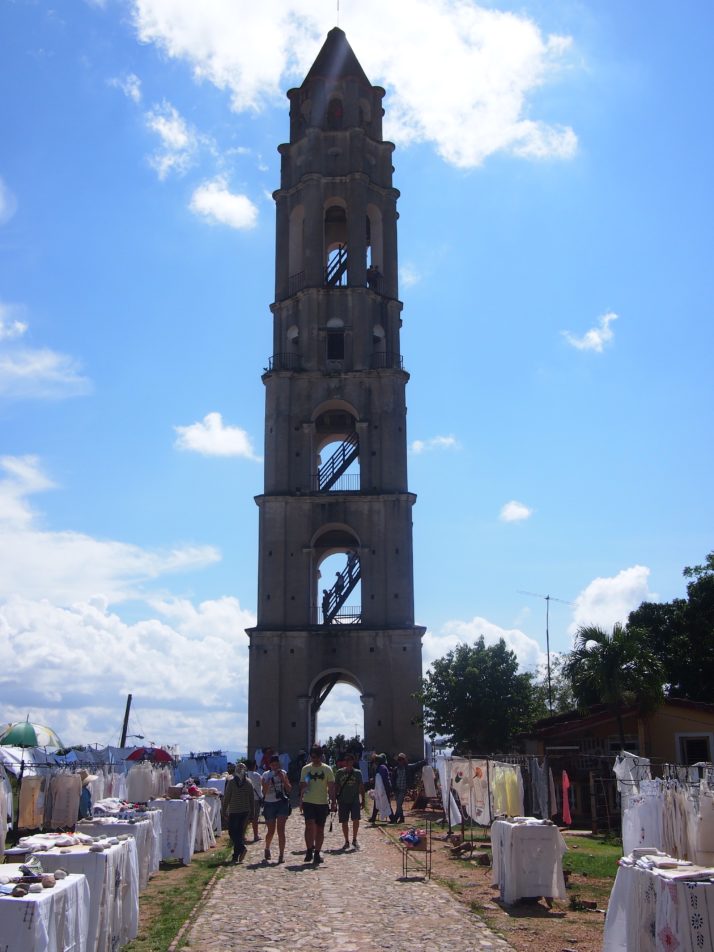 The tower at Manaca Iznaga is approached along a path lined with stalls selling local embroidery
The tower at Manaca Iznaga is approached along a path lined with stalls selling local embroidery
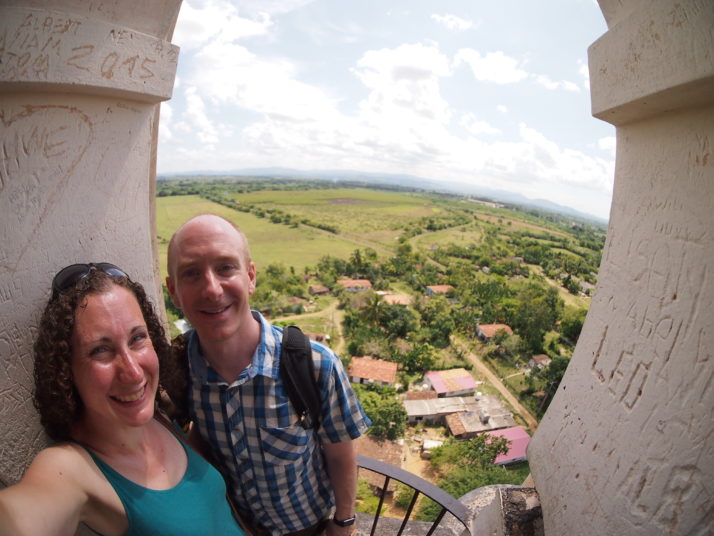 Another nice view from the top of the tower at Manaca Iznaga
Another nice view from the top of the tower at Manaca Iznaga
Our final stop in the valley was at Casa Guáimaro. When we arrived we were the only people there and the lady custodian began showing us around the house with its frescoed walls and period furniture explaining the history of the Borrell family who had built it, then in just a few generations lost it, and its subsequent usage as offices, a school and even housing for seven local families! My Spanish isn’t good enough to ask how the wall paintings were preserved during that time, I can only imagine that they had been painted over and then uncovered later. About halfway through the tour the lady began distractedly glancing out of the window and two minutes later we found out why when six bus loads of children on a church trip from Cienfuegos rolled up and started invading all doors. We were handed off to one of the bus drivers to be shown the final two rooms while she tried to contain the crowds…
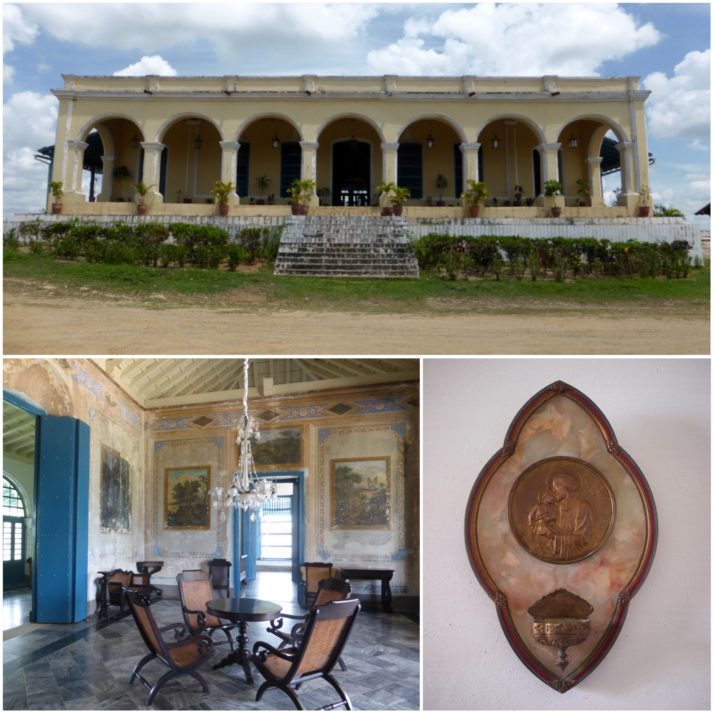 Casa Guáimaro; the wall paintings in the entrance way shows scenes of European cities; a holy water holder in the small family chapel
Casa Guáimaro; the wall paintings in the entrance way shows scenes of European cities; a holy water holder in the small family chapel
We enjoyed the variety of the sights in the Valley de los Ingenios, I had thought that it might get a bit repetitive visiting old sugar plantations but each stop had something different to see. On the way back into the city our driver asked if we’d like to stop at a pottery workshop and we agreed. It was interesting to see the craftsmen working so quickly and uniformly and we admired everything we were shown so our driver was rather confused when we didn’t want to buy anything (I think he would get a commision) but we genuinely don’t have a need for a multi-coloured ceramic mobile or vase.
On our final day, we took a walk away from the bustling touristy centre to the west towards the cemetery passing lots of normal Cuban life on the way with roadside butchers, greengrocers, pizza shops and even a barber who Andrew was able to persuade to cut his hair for just a little more than the locals’ price.
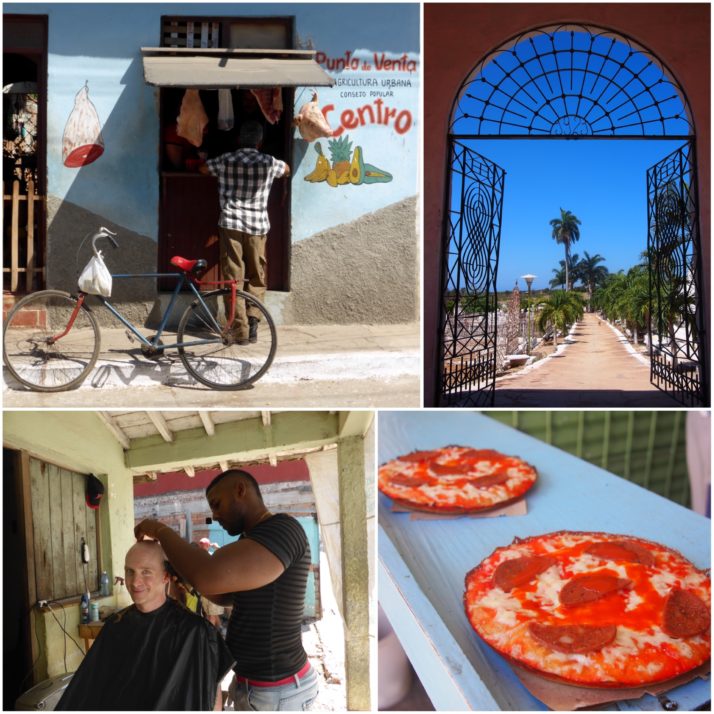 Clockwise from top left: a pig’s head hangs outside a butcher’s shop; gateway into the cemetery; pizza for lunch; the barber had a price list on the wall but insisted that the tourist price was different – he looked rather uncomfortable when we pointed out that all hair is the same
Clockwise from top left: a pig’s head hangs outside a butcher’s shop; gateway into the cemetery; pizza for lunch; the barber had a price list on the wall but insisted that the tourist price was different – he looked rather uncomfortable when we pointed out that all hair is the same
In the afternoon we took the tourist bus to the beach, Playa Ancon (for the record we should have believed the taxi driver and hired a colectivo taxi for the same price – we would have had some flexibility over times and it wouldn’t have been such a crush on the way back). After the beautiful beaches we’d visited along the north coast of the island, Playa Ancon was a bit of a disappointment, nice enough but just not as perfect. We took a walk away from the crowds towards the end of the peninsula then, back at the beach, relaxed with a beer in one of the small bars with a view of the waves.
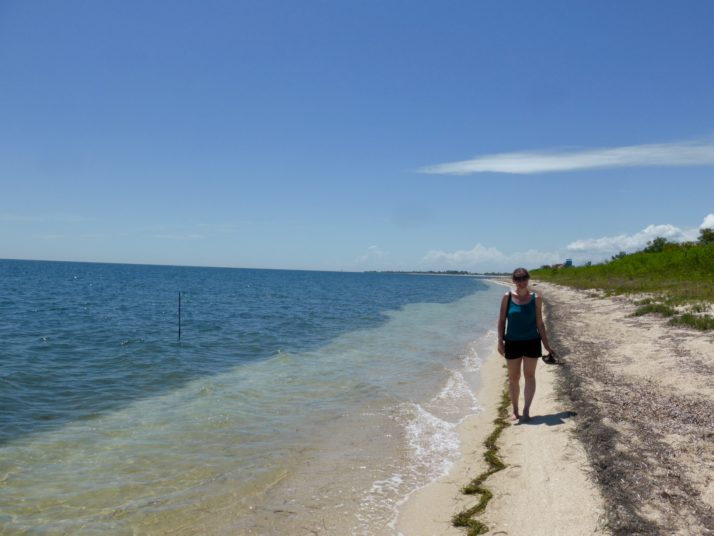 Wandering away from the crowds at Playa Ancon
Wandering away from the crowds at Playa Ancon

 two year trip
two year trip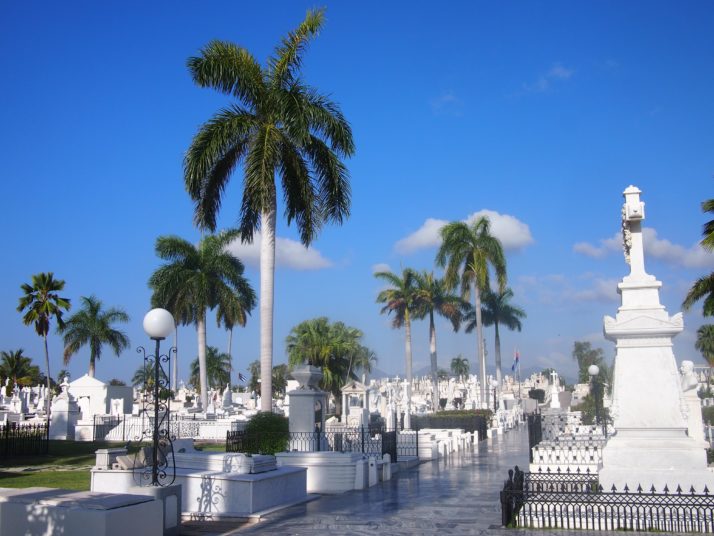 The first cemetery that we visited was Santa Ifigenia in Santiago de Cuba, a sea of white marble and palm trees against the blue Caribbean sky
The first cemetery that we visited was Santa Ifigenia in Santiago de Cuba, a sea of white marble and palm trees against the blue Caribbean sky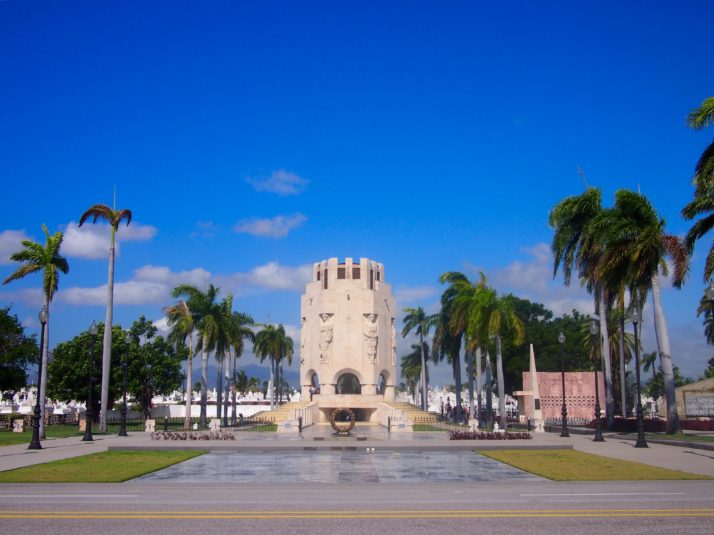 Santa Ifigenia cemetery is the resting place of
Santa Ifigenia cemetery is the resting place of 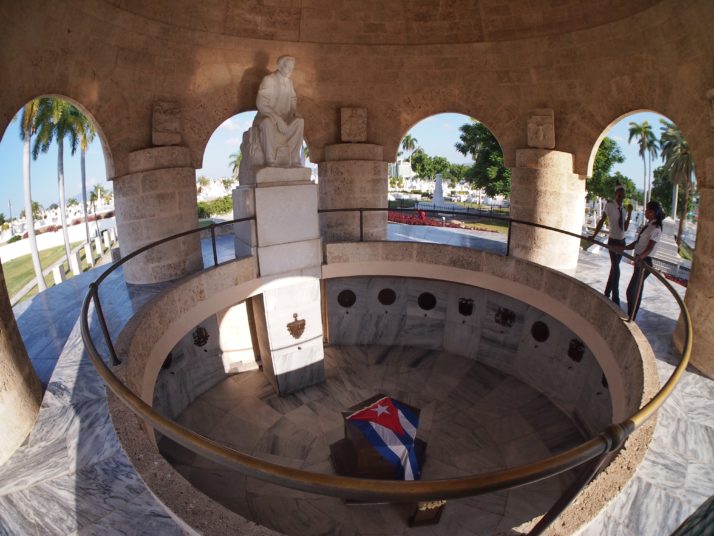 Inside José Martí’s mausoleum, the casket is draped in a Cuban flag and catches daily shafts of sunlight in response to a line in one of his poems about being buried with his visage facing the sun
Inside José Martí’s mausoleum, the casket is draped in a Cuban flag and catches daily shafts of sunlight in response to a line in one of his poems about being buried with his visage facing the sun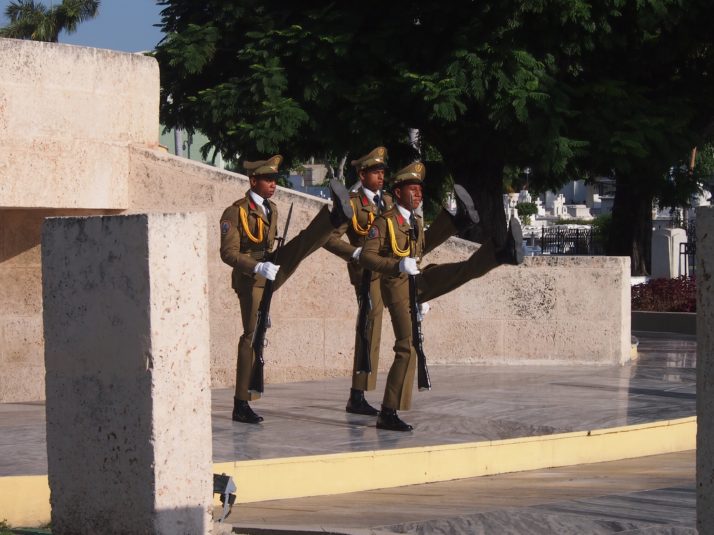 There is a twice hourly changing of the guard ceremony at José Martí’s tomb. At 8.30am we were the only ones there, by 10.30am the audience lining the path was large.
There is a twice hourly changing of the guard ceremony at José Martí’s tomb. At 8.30am we were the only ones there, by 10.30am the audience lining the path was large.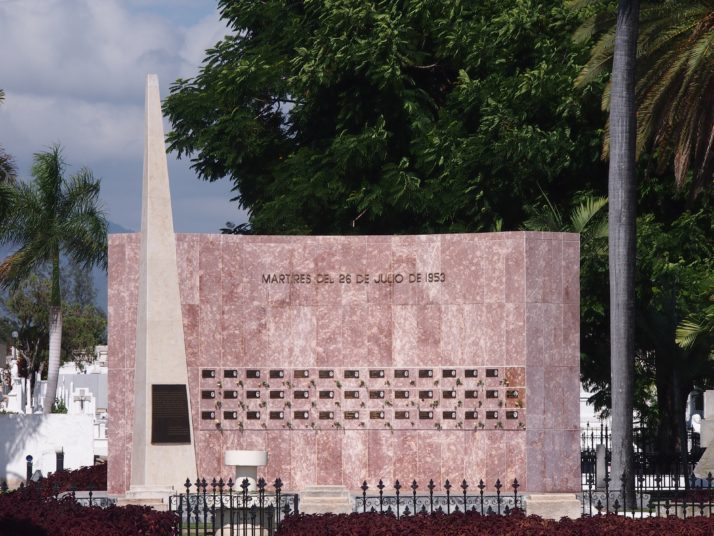 All the cemeteries we visited had mausoleums for soldiers killed during the revolutionary fighting, this one honours those who lost their lives during the Moncada Barracks attacks
All the cemeteries we visited had mausoleums for soldiers killed during the revolutionary fighting, this one honours those who lost their lives during the Moncada Barracks attacks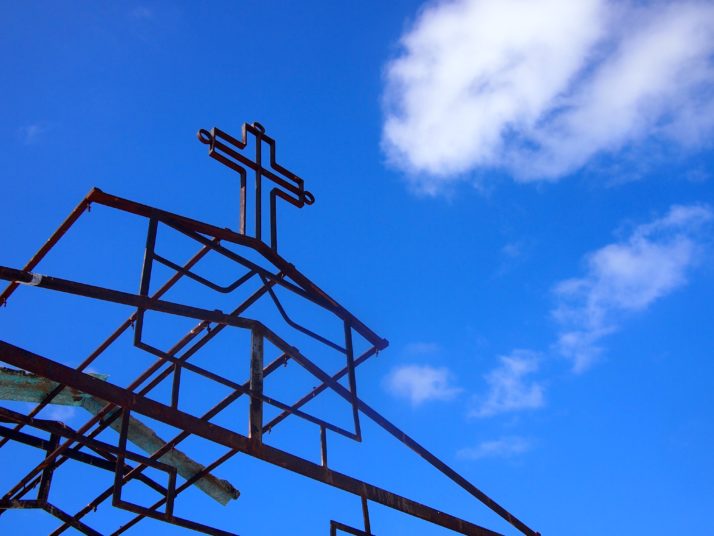 Most of the gravestones at Santa Ifigenia cemetery were white marble but there were a few exceptions like this metal canopy with a cross
Most of the gravestones at Santa Ifigenia cemetery were white marble but there were a few exceptions like this metal canopy with a cross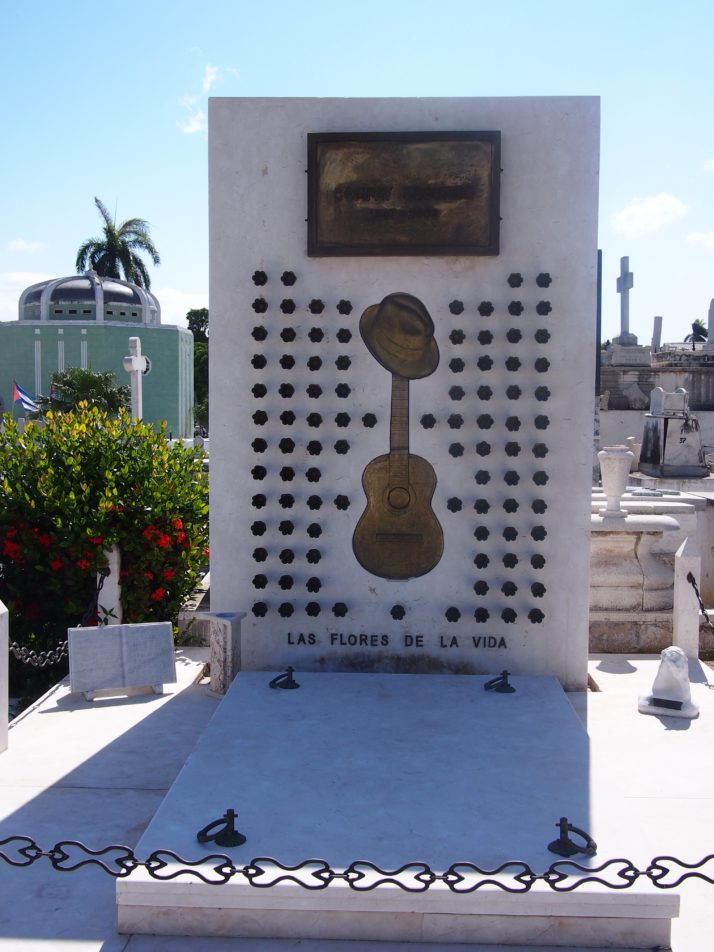
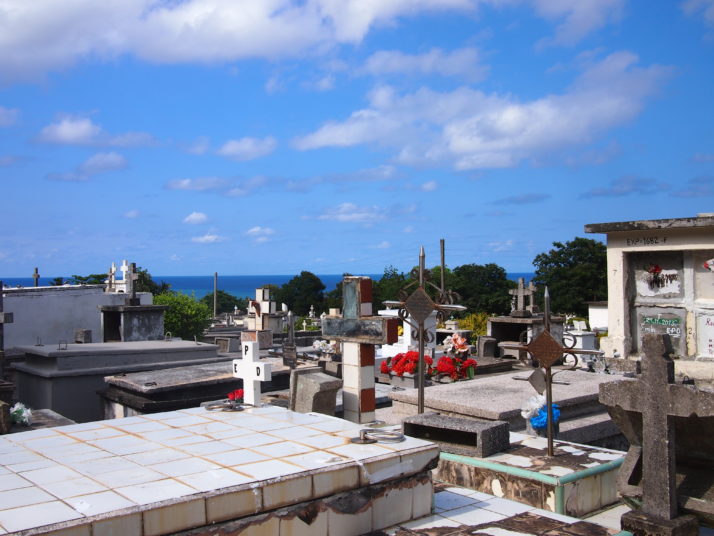 The cemetery in Baracoa was much less grand than the one in Santiago but it had a beautiful setting overlooking the sea
The cemetery in Baracoa was much less grand than the one in Santiago but it had a beautiful setting overlooking the sea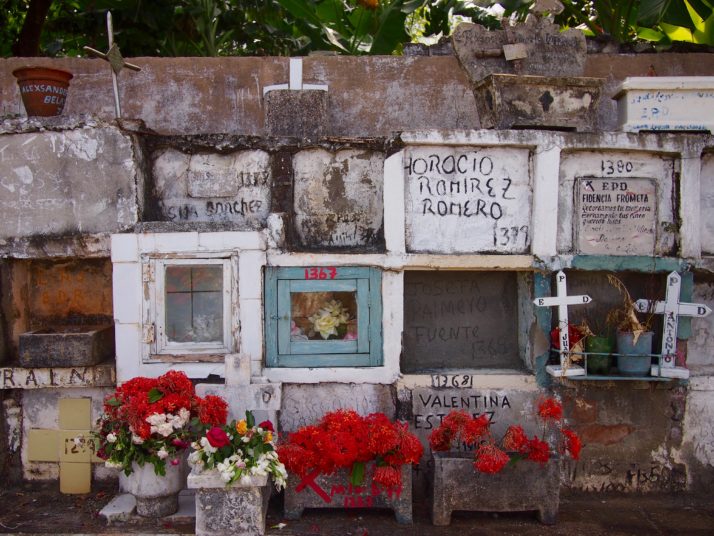 Every cemetery we visited had huge blocks containing square niches, presumably for ashes (there was usually a crematorium building hidden in a back corner as well). Some were simply decorated with the deceased’s name either handpainted or scratched into the wet cement while others had professional plaques, flowers or other decorations
Every cemetery we visited had huge blocks containing square niches, presumably for ashes (there was usually a crematorium building hidden in a back corner as well). Some were simply decorated with the deceased’s name either handpainted or scratched into the wet cement while others had professional plaques, flowers or other decorations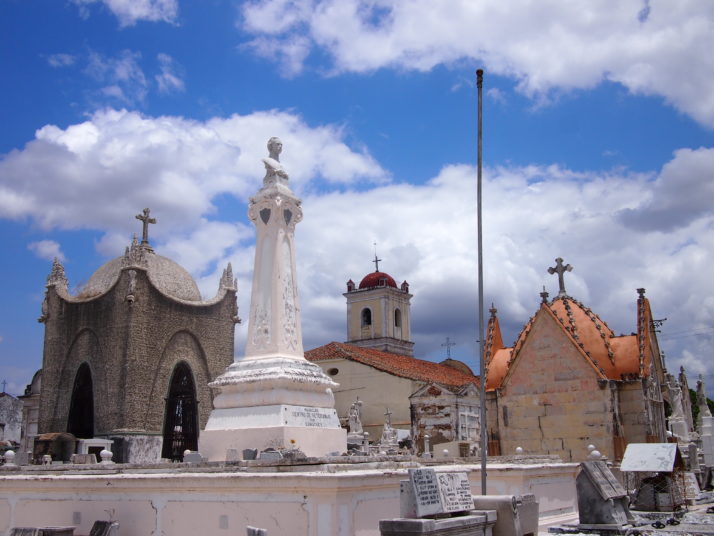 The cemetery in Camagüey was one of my favourites and with barely any other visitors (and no other tourists) we were free to have a good look around. These grand tombs are close to the entrance near the Iglesia de San Cristo de Buen Viaje (Church of St Christopher).
The cemetery in Camagüey was one of my favourites and with barely any other visitors (and no other tourists) we were free to have a good look around. These grand tombs are close to the entrance near the Iglesia de San Cristo de Buen Viaje (Church of St Christopher).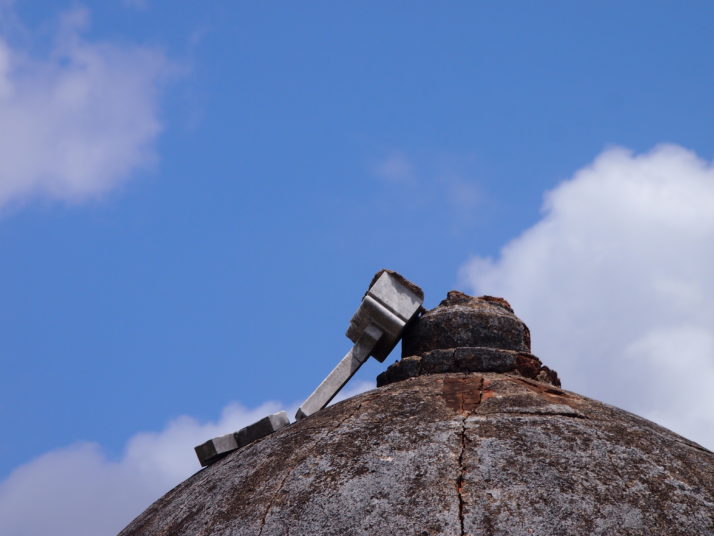 Further into the cemetery more dilapidation was obvious such as this fallen cross
Further into the cemetery more dilapidation was obvious such as this fallen cross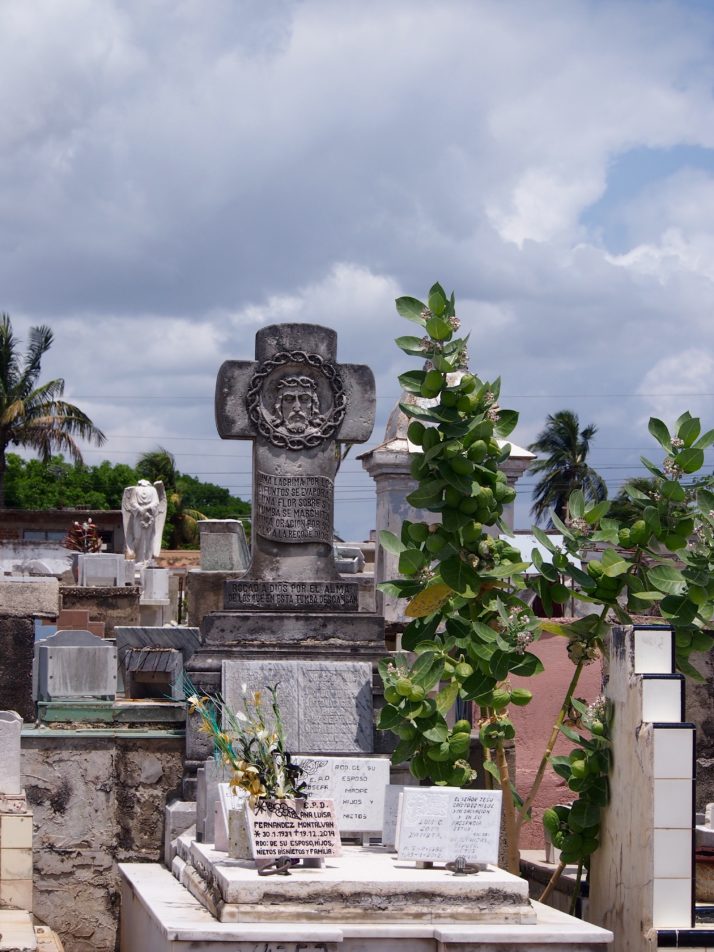 Plots often seemed to contain whole families with a crowd of plaques on top of the grave, each carrying a different name
Plots often seemed to contain whole families with a crowd of plaques on top of the grave, each carrying a different name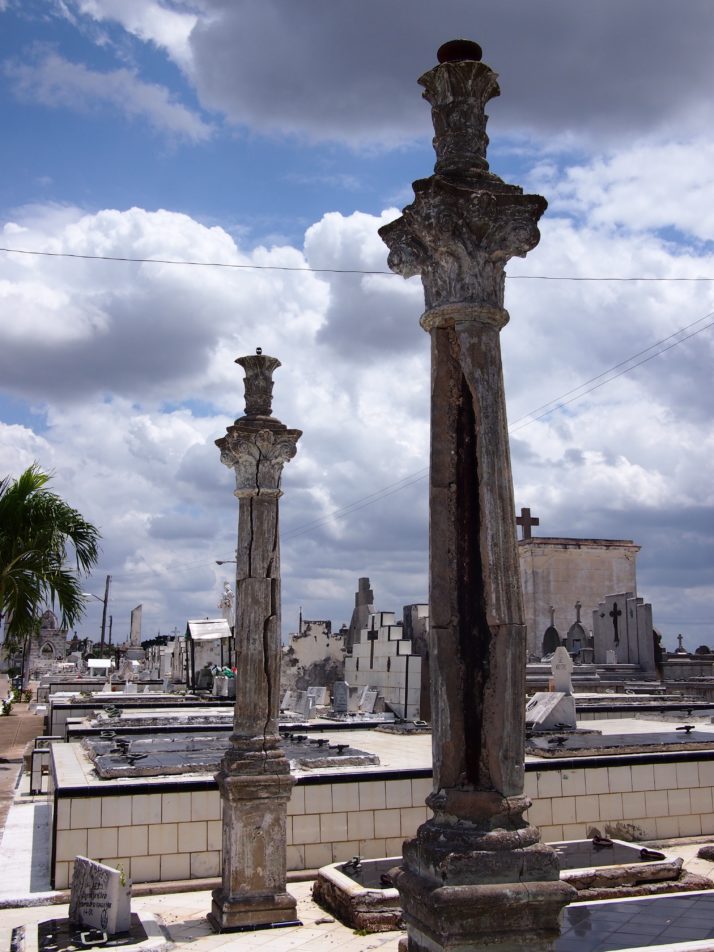 Columns that look as if they’re about to fall apart in Camagüey
Columns that look as if they’re about to fall apart in Camagüey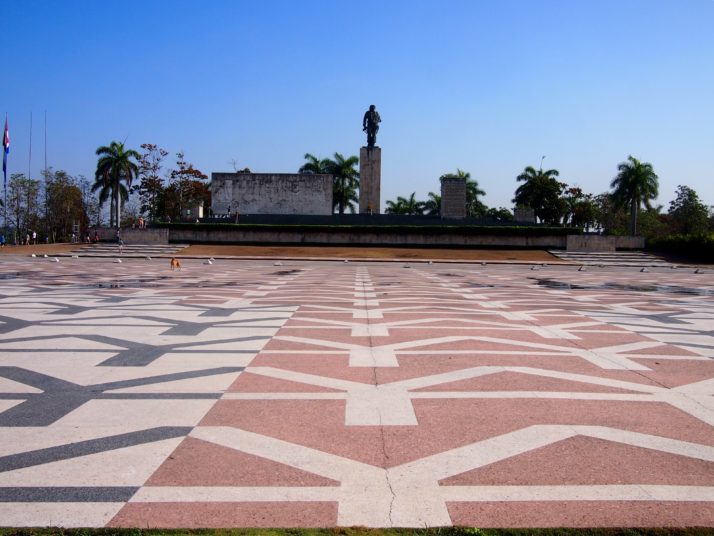 In Santa Clara we didn’t visit the cemetery but the city is home to the most famous mausoleum in the country which contains the remains of Ernesto ‘Che’ Guevara and 16 of the 37 fighters who were killed alongside him in Bolivia. Underneath the statue is a peaceful room of remembrance and an interesting museum documenting Che’s life.
In Santa Clara we didn’t visit the cemetery but the city is home to the most famous mausoleum in the country which contains the remains of Ernesto ‘Che’ Guevara and 16 of the 37 fighters who were killed alongside him in Bolivia. Underneath the statue is a peaceful room of remembrance and an interesting museum documenting Che’s life.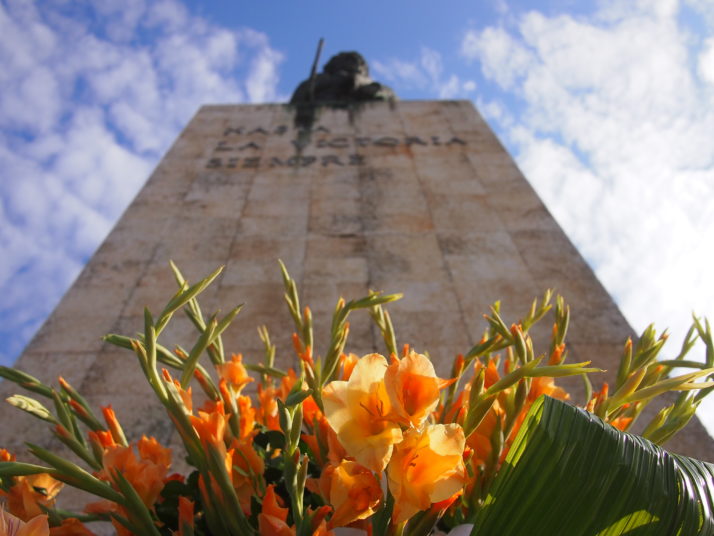 Fresh flowers are placed below the statue of Che each morning.
Fresh flowers are placed below the statue of Che each morning.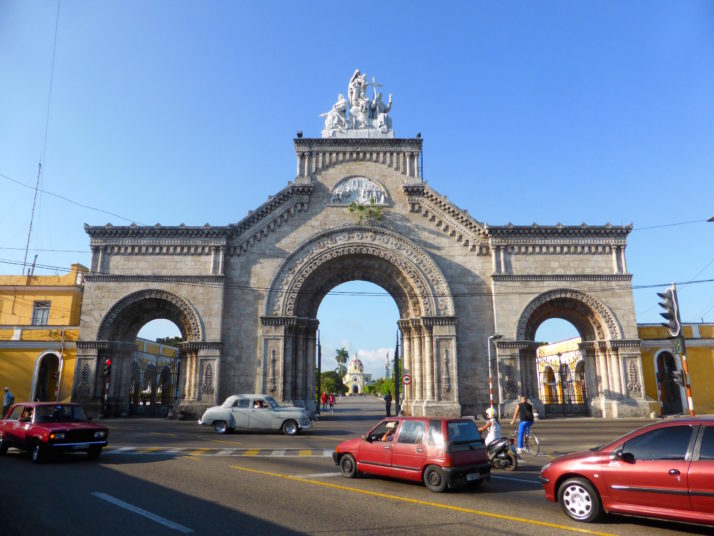 The Necrópolis Cristóbal Colón (Christopher Columbus cemetery) in Havana is enormous and worthy of this imposing entrance gate
The Necrópolis Cristóbal Colón (Christopher Columbus cemetery) in Havana is enormous and worthy of this imposing entrance gate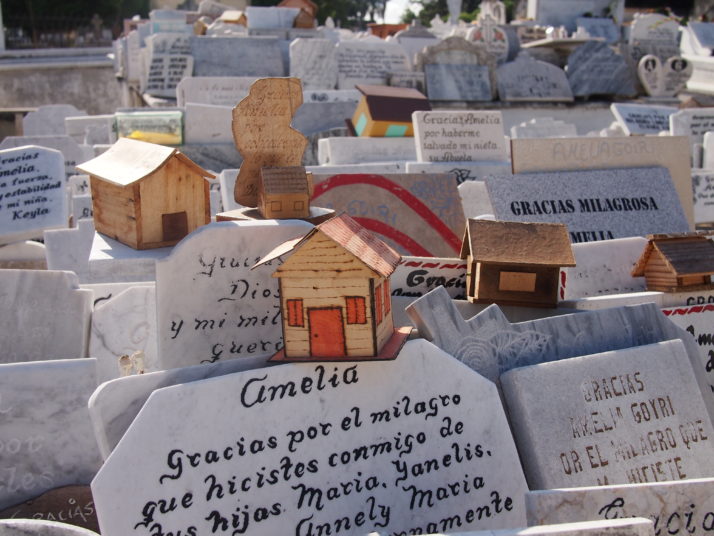 The most famous grave in the cemetery belongs to Amelia Goyri, also known as La Milagrosa or miracle-worker. She died in childbirth in 1901 and was buried with her son. The story goes that when the grave was opened some years late Amelia’s body was uncorrupted and the baby was found not at her feet but in her arms. Since then locals have prayed for her to help with their hopes for children, new houses, etc and now several nearby plots have been overtaken with thank you messages from thoses whose wishes have been fulfilled.
The most famous grave in the cemetery belongs to Amelia Goyri, also known as La Milagrosa or miracle-worker. She died in childbirth in 1901 and was buried with her son. The story goes that when the grave was opened some years late Amelia’s body was uncorrupted and the baby was found not at her feet but in her arms. Since then locals have prayed for her to help with their hopes for children, new houses, etc and now several nearby plots have been overtaken with thank you messages from thoses whose wishes have been fulfilled.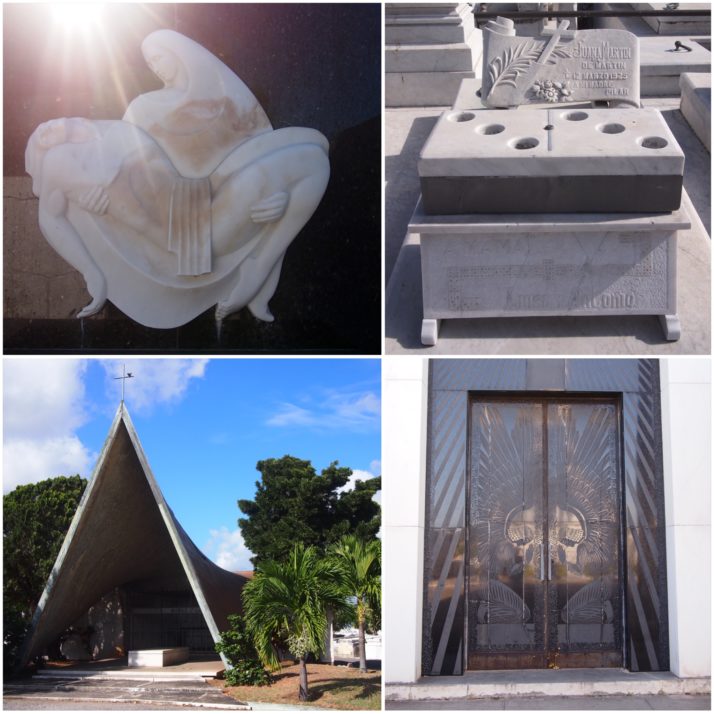 We enjoyed some of the modern graves in the Necrópolis Cristóbal Colón (clockwise from top left): a modern take on the Pietà by sculptor Rita Longa; according to the internet (!), Juana Martin died while playing dominoes; the glass doors on the pantheon of the Baró family were designed by Lalique; tomb of Nuñes Gálvez
We enjoyed some of the modern graves in the Necrópolis Cristóbal Colón (clockwise from top left): a modern take on the Pietà by sculptor Rita Longa; according to the internet (!), Juana Martin died while playing dominoes; the glass doors on the pantheon of the Baró family were designed by Lalique; tomb of Nuñes Gálvez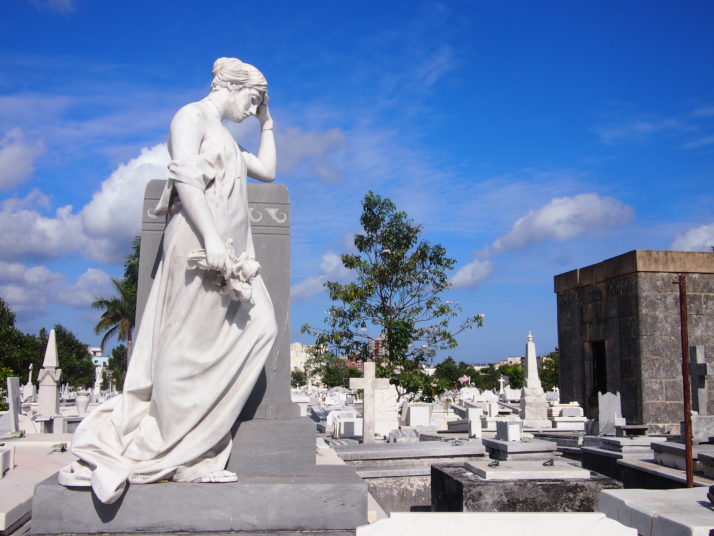 But there is plenty of beautiful white marble as well
But there is plenty of beautiful white marble as well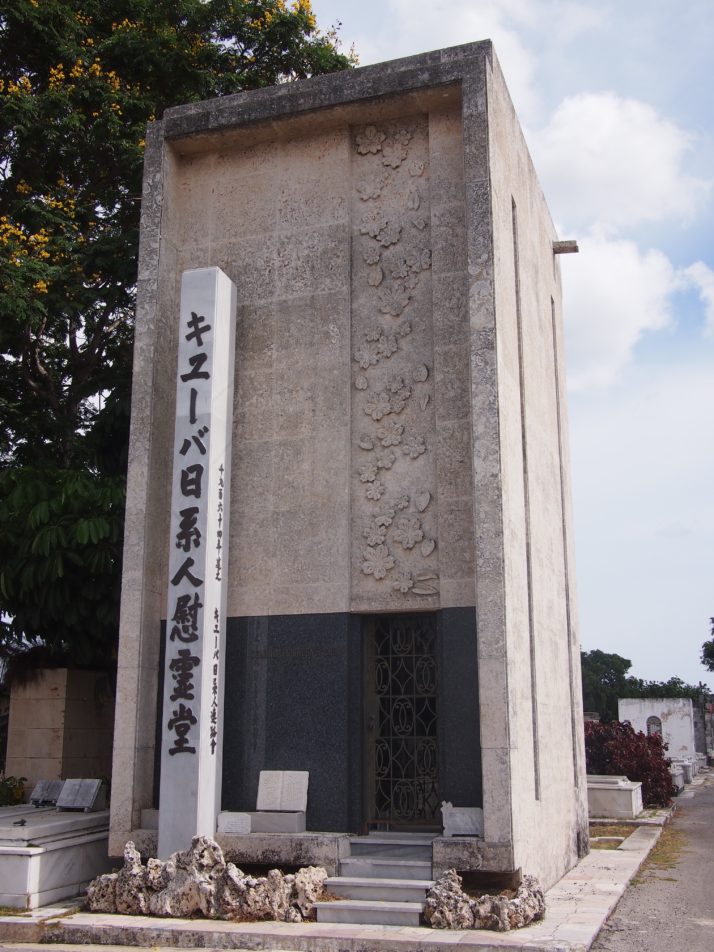 There were a number of mausoleums for societies like this one for the Japanese Colony of Cuba. Inside are walls of square niches.
There were a number of mausoleums for societies like this one for the Japanese Colony of Cuba. Inside are walls of square niches.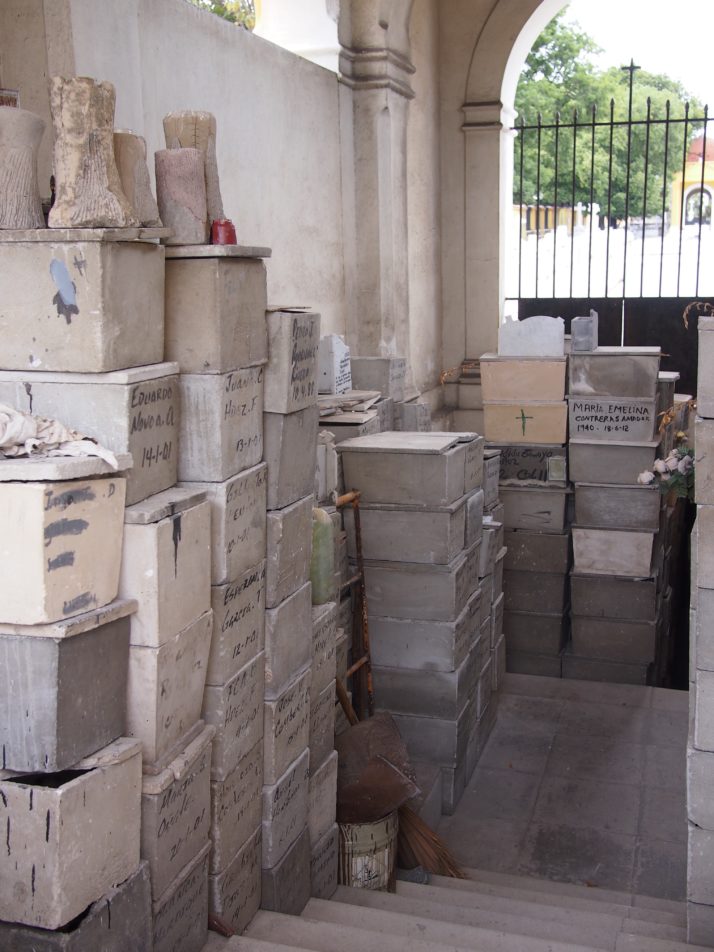 The Tobías Gallery is a 100m long underground gallery. We couldn’t enter but from what we could see from the doorway it looks to be piled high with small boxes like these which presumably contain bones or ashes
The Tobías Gallery is a 100m long underground gallery. We couldn’t enter but from what we could see from the doorway it looks to be piled high with small boxes like these which presumably contain bones or ashes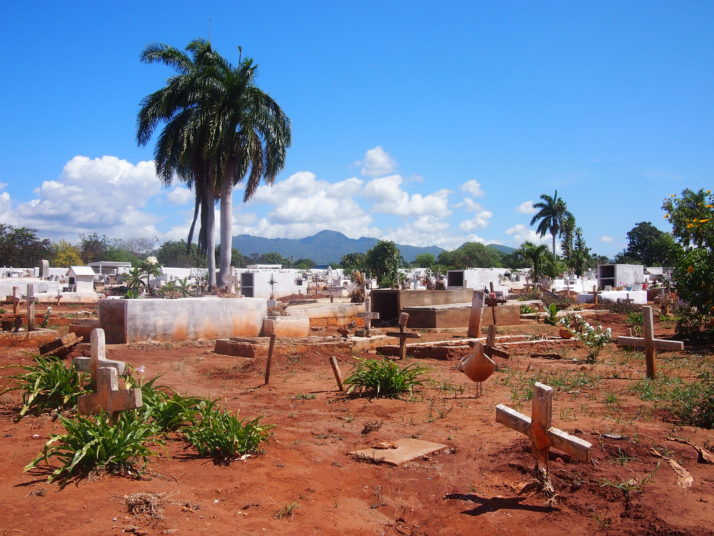 We visited the cemetery in Trinidad mainly to have a destination away from the tourist-filled city centre. We were rewarded with this tropically apocalyptic view.
We visited the cemetery in Trinidad mainly to have a destination away from the tourist-filled city centre. We were rewarded with this tropically apocalyptic view.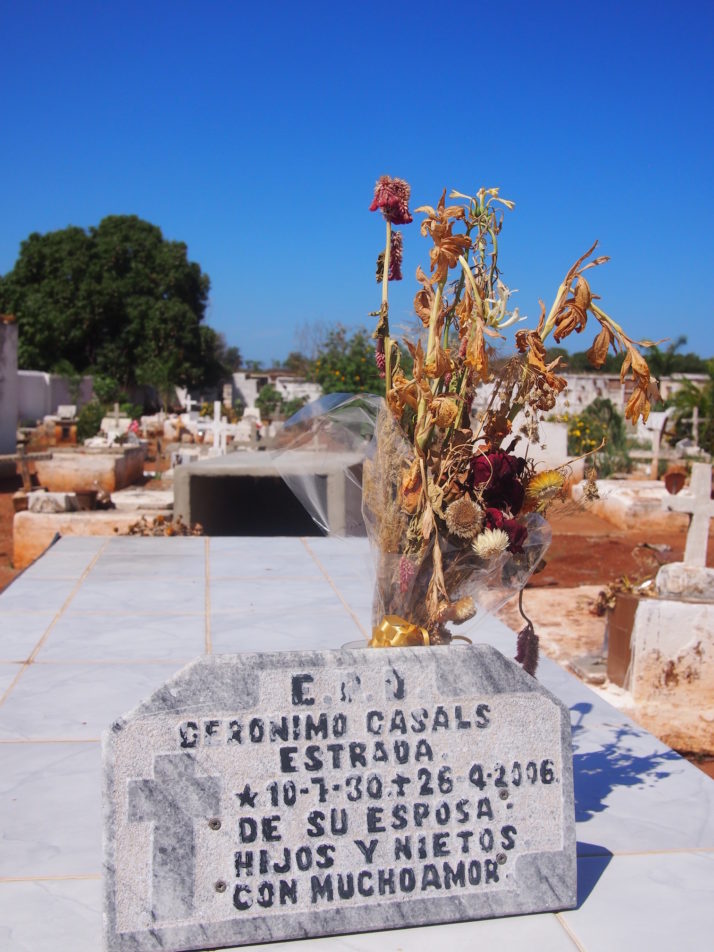 Flowers dry out very quickly in the hot Cuban sun and many graves had fake rather than fresh flowers.
Flowers dry out very quickly in the hot Cuban sun and many graves had fake rather than fresh flowers.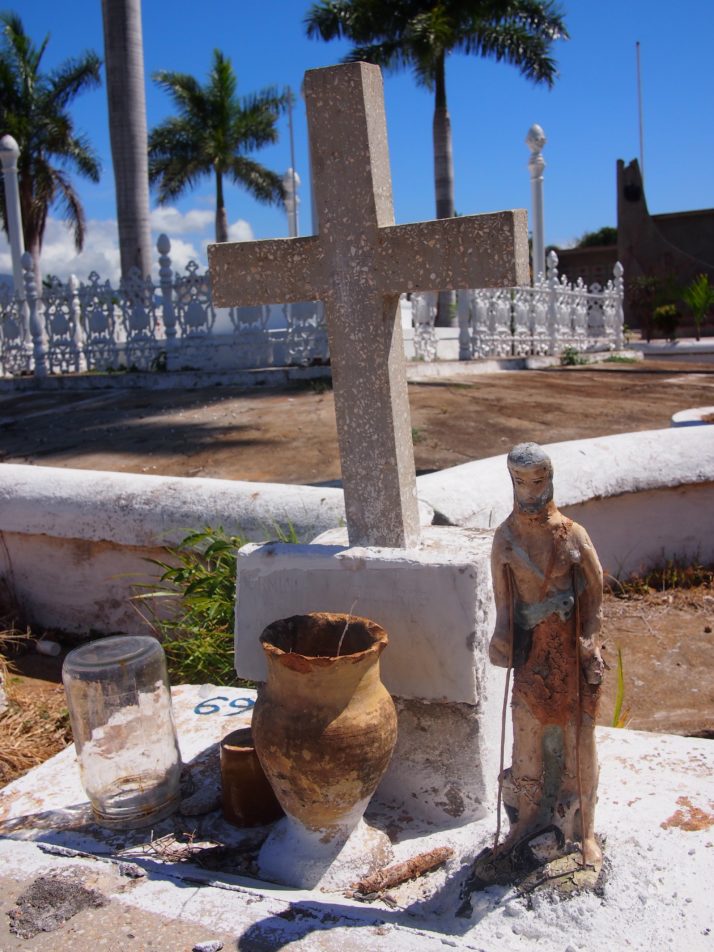 This grave is topped with a statue of Babaluaye, one of the orishas from Santeria, the religion fused from African animisism and Catholicism. It also holds what I think is the remains of a cigar
This grave is topped with a statue of Babaluaye, one of the orishas from Santeria, the religion fused from African animisism and Catholicism. It also holds what I think is the remains of a cigar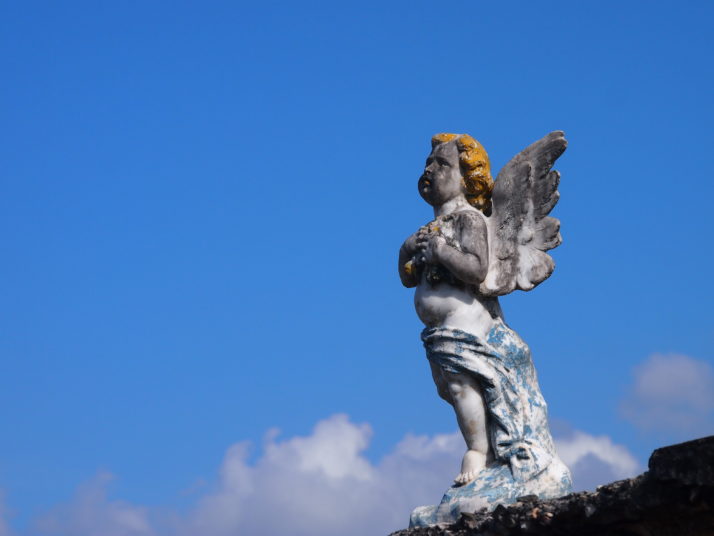 A forlorn and battered cherub tops a tomb in Morón
A forlorn and battered cherub tops a tomb in Morón